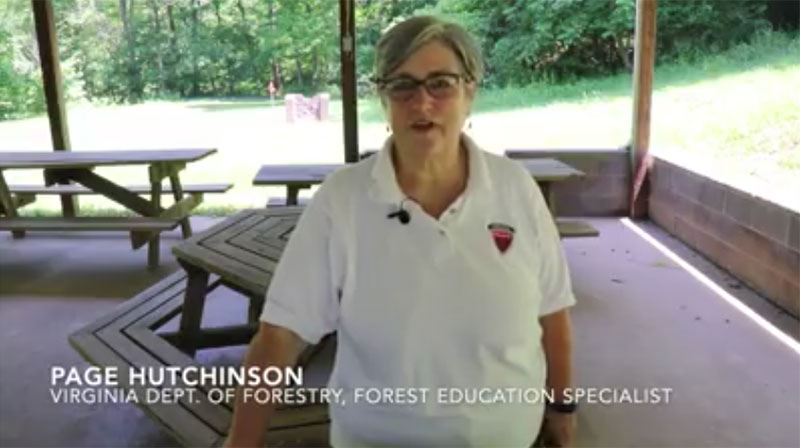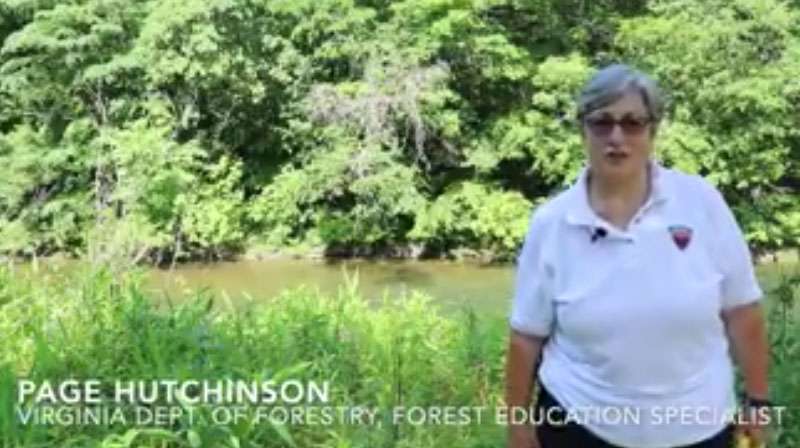Video Library
Jump straight to a topic:
Riparian Forest Buffers
Defining a Riparian Buffer
This video, filmed in Swoope, Virginia on the farm, offers a definition of riparian buffer and shows what a well functioning riparian buffer looks like.
Riparian Restoration 101: Buffer Design, Dairy Farms Part I
Learn from Ryan Davis, Pennsylvania Forest Program Manager, about the important considerations to make when designing a riparian forest buffer in an existing pasture where livestock currently have access to the stream.
Page H. Demo: Capturing runoff
VDOF forest educator Page H. leads us through an easy activity to do with your kids & teach them about the importance of forest buffers. All you need is a tray, water, sponges and some creativity!
Stories from the Streams: Back to Our Roots
Did you know that planting trees along a stream can filter out pollutants and dramatically improve water quality? Episode 1 in the “Stories From the Streams” video series from WHYY TV12.
Riparian Buffers
We all live downstream. Learn one way that people protect our water by using riparian buffers. Virginia Standards of Learning touched upon: (Science) 2.7 bc, 3.8 acd, 4.8 abd, 5.8 d, 6.6 df, 6.8,
Riparian Restoration 101: How to Plant a Tree
Would you guess that planting the trees is the easiest part of establishing a riparian forest buffer? Learn from Ryan Davis, Pennsylvania Forest Program Manager, how to plant a containerized seedling, as well as install a tree tube and bird net.
Page H. Demo: Measuring Benefits
Forested buffers along rivers & streams are critical for #water quality & #wildlife habitat. Page H. demos an activity in which children can measure out how big a riparian buffer needs to be– stream optional but preferred!
Agricultural Infrastructure
Supporting Virginia Farmers
Agriculture is the largest source of nutrient and sediment pollution reaching local streams and the Chesapeake Bay. While many well-operated farms employ sound conservation practices that protect water quality, a lack of funding and technical resources prevent many farmers from implementing such practices. Consequentially, excess nutrients, sediment, bacteria, and toxins flow into local waterways, including the Chesapeake Bay. The Virginia Agricultural Cost-Share Program (VACS) has assisted thousands of farmers in implementing more than 50 different types of best management practices (BMPs) to reduce pollution from reaching Virginia’s waterways. These BMPs include stream exclusion systems, which keep livestock out of streams while providing alternative water sources; nutrient management plans, which help ensure farmers use a sustainable amount of fertilizer; riparian buffers; conservation tillage; cover crops; and many other practices essential to protecting our streams, lakes, rivers, and bays.
Cattle and Conservation
Learn from farmers about Mountain Castles Soil & Water Conservation District cost share programs and how together we can improve both your farm’s profitability and water quality.
Let the Earth Heal
More than anyone, farmers understand how important it is to take care of the land. Not only do they rely on it to do their job, but they reap the benefits of being good stewards to land that is healthy and well maintained. Farm manager Tony Pullaro grew up on a family farm in New Garden, Virginia, but has been managing Edgemont Farm for the past 25 years. He explains what he has seen change on his farm after installing stream fencing and forest buffers on the property.
Bay 101: Agriculture
Learn about the importance of agriculture in the Chesapeake Bay region. Mark Dubin of the University of Maryland Extension and Jennifer Volk of the University of Delaware Cooperative Extension discuss agriculture’s impact on the Chesapeake Bay and conservation practices that farmers have employed to benefit the environment both locally and downstream.
Streambank Stabilization
Riparian Restoration 101: Stream Restoration
Severely eroded stream banks sometimes require restoration before the trees are planted in a riparian forest buffer. Streambank restoration is an expensive practice. Ryan Davis, Pennsylvania Forest Program Manager, offers his rule-of-thumb for in-field determination of whether stream restoration is needed. This video is part of the Riparian Restoration 101 series on buffer design, implementation, and maintenance.
Harvesting and Planting Live Stakes
Live staking is a low-cost way to plant streamside buffers. Cuttings take root in streambanks and help keep soil in place, and improve water quality. Learn about how to harvest and plant live stakes.
Tree Talk: Live Staking
Learn about Live Staking, the free and easy tree/shrub planting technique!
Buffer Stewardship
Riparian Restoration 101: A Typically Maintained Buffer
Buffer maintenance is crucial, especially in the first five years after planting. But what does a “typically maintained” buffer look like if it is managed as recommended by experts?
Penn State Extension: Replanting Dead Trees In Your Buffer
In the first few years of establishment, it’s good to replace riparian buffer trees that die and try to eliminate the causes of these mortalities in the future.
Penn State Extension: Maintaining Tree Tubes and Shelters in Buffers
Many new riparian buffers include tree tubes or shelters to protect the newly planted trees from environmental and manmade stress. Those tubes need to be properly maintained.
Penn State Extension: Mulching for Weed Control in Buffers
Mulching is one option for helping to control weeds in your newly planted riparian buffer.
Penn State Extension: Noxious Weeds
All weeds in a new streamside planting should be managed to help your plants succeed, but by law, noxious weeds must be managed and controlled.
Riparian Restoration 101: Site-wide Maintenance
Learn from Ryan Davis, Pennsylvania Forest Program Manager, about what side-wide maintenance, like mowing and herbicide application, looks like and adaptations you can use in certain challenging situations.
Penn State Extension: Integrated Pest Prevention in Buffers
Newly planted riparian buffers are subject to many pests. To make your buffer successful, your pest management plan needs to identify which pests you have and include a variety of strategies to deal with those pests.
Penn State Extension: Invasive Species Management in Buffers
This video provides a brief introduction to the identification and management of five commonly encountered invasive riparian buffer weeds in Pennsylvania.
Penn State Extension: Tree Tube Pest Management in Buffers
Tree tubes are a great way to help your newly planted riparian buffer trees grow, but they can also make great homes for weeds and wildlife pests.
Penn State Extension: Understanding When to Remove Tree Tubes in Your Buffer
Knowing when it’s time to remove tree tubes or shelters from your riparian buffer trees can be difficult. Taking them off too soon or too late can create additional issues and work for you and your trees.
Penn State Extension: Design Considerations for Maintaining Your Buffer
Learn about recommended maintenance and proper planning for your riparian buffer.
Wildlife Habitat
From the Field: Linking land and water in brook trout conservation
Brook trout play a critical role in the Chesapeake Bay watershed, but without cool, clean water, the fish cannot survive. Working in headwater states, Chesapeake Bay Program partners are promoting land conservation and habitat restoration as ways to clean up local waterways and conserve the iconic species.
Leibs Creek Buffer Planting
About 40 volunteers from the Muddy Creek Chapter of Trout Unlimited teamed up one day with the Alliance last fall to plant a 500-tree riparian buffer along a trout-friendly creek in southern Pennsylvania.



